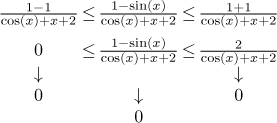Problem: Evaluate (if they exist) limits of the function
![]()
at x = 0 and at infinity.
Solution:
Limit at x = 0.
This is a standard problem, we want to find a limit of an expression that
exists on a reduced neighborhood of the limit point. This is not actually all
that clear, so we start by rewriting the given function into its proper
form, since
general powers have to be
investigated in the "e to ln" form.

When x is close to 0, for instance if
This confirms that the question makes sense and we can start the usual way, substitute 0 into the expression. Since we will be working with the function in the "e to ln" form and the exponential can be pulled out of the limit, we will just focus on the expression inside the exponential for a while.
![]()
Dividing a non-zero number by zero is an indeterminate expression, unless we can force the zero in the denominator to be one-sided. There does not seem to be any reason for this here, which makes us suspicious, perhaps the limit does not exist. To make sure, we use the standard trick and look at one-sided limits:

Since the one-sided limits do not agree, the given (two-sided) limit does not
exist. Note that we had to inquire about the value of
Now we would like to claim that if we are raising e to an expression that does not have a limit, we obtain something that does not have a limit. If fact, in this particular case it is true, but it is not immediately clear and it is definitely not a rule that would work for all (even nice) functions. Thus to make sure and show a proper solution we look at one-sided limits of the given function f itself, of course we will use the above calculations.

This confirms that the limit of f at
Limit at infinity.
From
![]()
Is this an indeterminate expression? This is not immediately clear. One can actually show that the numerator goes to infinity (see below), but we do not really need it, since we have the wonderful more general form of l'Hospital's rule that will now save our time.

What can we say about the expressions in the fraction? In the numerator we
have an oscillating but bounded expression, it keeps oscillating between 0
and 2. In the denominator, the cosine - a bounded function - is added to
the expression
This confirms that the expression in the denominator goes to infinity, now we could use the rule "bounded divided by infinity is zero." For the sake of completeness we will actually prove this conclusion, this time we will have to use two-sided comparison, that is, the Squeeze theorem:

Thus we confirmed that the expression goes to zero at infinity. Now we have to remember that we are not really interested in this particular expression, but in "e to this expression". Therefore we have to return back to the given function.
![]()